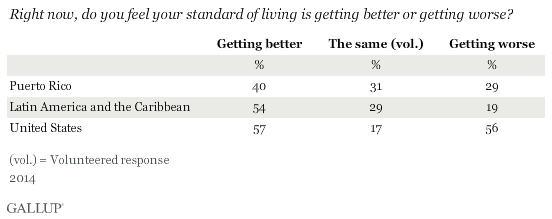Story Highlights
- Puerto Rico more pessimistic than U.S., most of Latin America
- 19% approve of Gov. Alejandro Garcia Padilla's job performance
- Four in 10 believe their standard of living is improving
WASHINGTON, D.C. -- Amid the ongoing debt crisis in Puerto Rico, 6% of the U.S. commonwealth's residents believe economic conditions on the island are getting better. To put this figure into perspective, if Puerto Rico were a U.S. state, it would rank well below the least optimistic state, West Virginia, where 24% say economic conditions are getting better. However, Puerto Rico also fares poorly compared with countries in Latin America and the Caribbean, where it ranks last in economic optimism, along with Venezuela.

Puerto Rico saw its economy begin to collapse before the onset of the global recession. This meltdown was hastened in 2006 when the U.S. Congress phased out federal tax incentives that encouraged manufacturers, particularly shoe factories and pharmaceutical firms, to open locations in Puerto Rico where they also could take advantage of low-cost labor. As U.S. and global growth slowed, Puerto Rico's government began borrowing money from any available source, including retirees' public pensions and Wall Street firms, to meet its obligations, accumulating approximately $72 billion worth of debt in the process.
Alejandro Garcia Padilla, governor of Puerto Rico since 2013, is trying to convince the U.S. Congress to change federal laws to allow the commonwealth to declare bankruptcy to restructure its debts and kick-start the economy; otherwise, he says, the island cannot pay back its debts. With his options running out, the governor told a News York Times interviewer in late June that Puerto Rico was heading into a "death spiral." Not surprisingly, fewer than one in five Puerto Ricans (19%) say they approve of the way Padilla is handling his job.

Outlook on Standard of Living Worse Than Average in the Region and the U.S.
Four in 10 Puerto Ricans say their standard of living is getting better, significantly lower than the median of 54% who say this in the Latin American and Caribbean region overall and the 57% of Americans who say the same. This is also lower than the least optimistic U.S. states, Alabama, Massachusetts and New Jersey, where 51% see things improving.

Bottom Line
Puerto Rico unveiled a five-year plan Wednesday that not only restructures its current debt load, but also plans for collecting taxes and delivering public services more efficiently, increasing business investment and job creation and putting more focus on infrastructure maintenance. The island's proposed measures are likely to face substantial political headwinds, including support from its own legislature and action from the U.S. Congress.
As this fiscal crisis continues to play out, it is possible more Puerto Ricans will look to U.S. statehood as a preferred alternative to remaining a commonwealth. In November 2012, 54% of Puerto Ricans voted in a nonbinding referendum to reject their island's status as a commonwealth; 61% of this group chose statehood as the alternative. The U.S. Congress approved $2.5 million in funding in January 2014 for a new statehood referendum in Puerto Rico, although it has yet to be scheduled.
These data are available in Gallup Analytics.
Survey Methods
Results are based on face-to-face interviews with 1,000 adults, aged 15 and older, conducted in 22 countries in South America and the Caribbean in 2014. For results based on the total sample of national adults, the margin of sampling error ranges from ±3.4 percentage points to ±5.2 percentage points at the 95% confidence level. Exceptions to this are Belize, Haiti, Jamaica and Puerto Rico, where 500 adults, aged 15 and older, were interviewed, with a margin of sampling error ranging from ±4.8 percentage points to ±5.2 percentage points. Interviews in Puerto Rico were conducted Dec. 13-21, 2014. Results in the U.S. overall are based on telephone interviews with 2,048 adults, aged 15 and older, conducted in May-June 2014 and September-October 2014, with a sampling error of ±2.8 percentage points. All reported margins of sampling error include computed design effects for weighting.
For more complete methodology and specific survey dates, please review Gallup's Country Data Set details.
Learn more about how the Gallup World Poll works.
